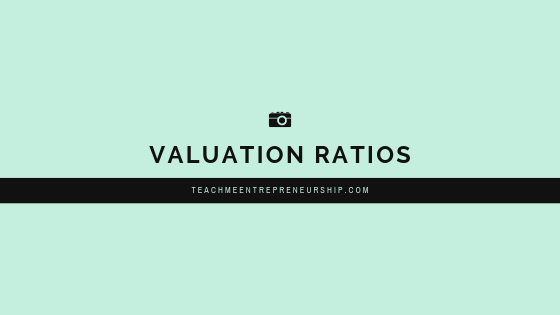Valuation ratios play a very important role in stock valuation. To understand the potential for stock picking to be profitable, we must first consider valuation ratios.
We must need to learn some basics about valuation ratios in order to apply that valuation to make a great investment decision.
- 1. What are Valuation Ratios?
- 2. List of Valuation Ratios
- 1. Price to Earnings Ratio
- 2. Price to Sales Ratio
- 3. Free Cash Flow to Equity
- 4. Return On Equity (ROE)
- 5. Return On Assets (ROA)
- 6. Return On Capital (ROC)
- 7. Beta Value
- 8. Variance & Covariance
- 9. Weighted Average Cost of Capital
- 10. Cost of Equity
- 11. Interest Coverage Ratio
1. What are Valuation Ratios?
There are many different approaches to valuation ratios, one can value many parts of a company such as; just the equity or one can value the entire firm.
(Damodaran, 2008) In this thesis, the two clubs will be valued entirely as two firms.
The reason for this is that it will lead to the most accurate comparison due to the simple reason that the two clubs are built up in different ways.
The purpose is to be able to draw a conclusion about the effects of the entire firm value, not single parts of the companies.
When it comes to the valuation of a firm, valuation ratios gives a good insight into the financial condition, there are many different aspects that one can take into consideration.
For example, one can value separate assets and smaller parts of a firm or one can value the firm from a larger and wider perspective.
Valuation ratios put that knowledge into the setting of an organization’s share price, It plays a very important role in evaluating the funding potential.
Valuation ratios give a predictable procedure to benchmarking and investigating patterns.
By using these valuation ratios one will also be able to get an understanding of how these firms are structured and organized.
The following paragraphs will give more specific information about the different valuation ratios.
2. List of Valuation Ratios
1. Price to Earnings Ratio
The price to earnings ratio is a metric used for company valuation and measures the current share price and the earnings per share.
The price to earnings ratio plays an important role to determine stock valuation.
Investors and analysts use this, price to earnings ratio to determine stock valuation.
This specific measure helps investors to see what the future prospects of the company’s stocks appear.
The price to earnings ratio is an important metric that can influence investors and help to determine whether they should buy a stock.
The price to earnings ratio open-up about how much money the potential investors need to pay for every $1 of earnings.
Typically lower the P/E ratio is the investor pays less for every $1 of earnings.
The ratio also helps investors to evaluate whether a company’s stock price is overvalued or undervalued.
This ratio helps investors to evaluate and compare a company against its own historical record.
Investors can easily anticipate future growth depending upon price to earnings ratio.
Generally, the higher the price to earnings ratio, the higher the future growth.
When the P/E ratio is high for stock this most often means that the investors have reason to believe that the stock will be more valuable in the future.
This measure obviously is not enough to build a case whether to invest in a company or not.
The P/E value of a company should, to be the most truthful, be used when comparing the company’s in the same business sector since the values that are involved in the formula are very different for different businesses.
Another important factor to take into consideration when working with the P/E ratio is that since the denominator; earnings per share is a book value which means that it is very often manipulated to make a company look more or less profitable.
The P/E might give a false impression of the value of the company’s stock and therefore one should only use it together with other measures.
Investors and analysts analyze the company’s price to earnings ratio when they consider if the share price performs exactly as stated in the projected earnings per share.
To calculate the price to earnings ratio you just need to divide the current stock price by the earnings per share (EPS).
Finding the current stock price or market price is very easy. Market value per share or current stock price is the cost of buying a share from a publicly-traded company on the stock market.
Finding out earning per share also refer as EPS is also easy can be calculated by taking a company’s net income over the last four quarters (twelve months) and then dividing by the number of shares outstanding.
You can also find out EPS on finance websites as a part of a freely available stock report.
2. Price to Sales Ratio
The price-to-sales, also refer as “price/sales” or “P/S ratio” is a metric used for stock valuation and uses a company’s market capitalization and revenue to consider whether the stock is valued properly.
This ratio completely depends upon revenue – not profits. Therefore it can help to evaluate the valuation of companies with little or no profits.
The price-to-sales ratio is a metric of the value that the potential investors are getting from a company’s stock.
Usually by illustrating that the investors are paying how much money for the stock per dollar of the company’s sales.
The typically a lower number for the ratio is preferred by analysts. The price-to-sales ratio of less than 1 proves that the investors are paying less than $1 per $1 of the company’s sales.
A firm with a low P/S ratio will have to make much larger increases in the net revenue than a firm with a high P/S ratio to become a better investment. That means higher the price to sales ratio the lower the net revenue.
To find out the price-to-sales ratio you just need to divide the company’s market capitalization by its total sales over a designated period or revenue over the past 12 months.
Lower price-to-sales ratio makes investment more attractive.
The price-to-sales ratio plays an important role in valuing growth stocks that have yet to turn a profit or while the company faces a temporary setback.
Reveal the market valuation by demonstrating how much the market values every dollar of the company’s sales.
For example, consider the company is not earning a profit yet, so the price to sales ratio will demonstrate whether the stock is undervalued or overvalued.
If in case of a lower P/S ratio than comparable companies in the same industry that is profitable, it can motivate the investors to buy the stocks because of low valuation.
3. Free Cash Flow to Equity
The Free Cash Flow to Equity describes how much a firm can payout to the equity investors after accounting all expenses, reinvestments and debt repayments.
If a company has a positive Free Cash Flow to Equity this means that the firm can pay out dividends or repurchased stocks to its equity holders without harming the company’s ongoing operations and future growth.
On the other hand, a negative Free Cash Flow to equity means that the entity or company must issue new equity to raise cash into the entity.
Analysts use the FCFE metric to determine the value of a company. This valuation method gained popularity as an alternative to the dividend discount model (DDM).
Analysts also use FCFE to make sure that if dividend payments and stock repurchases are paid with free cash flow to equity or some other form of financing.
Investors are looking for dividend payment and share repurchase that is fully paid by FCFE.
If in case of FCFE is less than the dividend payment and the company is funding with existing capital, debt or issuing new securities to buy back shares.
This is what investors don’t want to see in a current or prospective investment, even if interest rates are low.
If in case the company’s dividend payment funds are significantly lesser than the FCFE, that means the company is using the excess to raise its cash level or to invest in marketable securities.
If the company is spending funds to buy back shares or pay dividends is approximately equal to the FCFE, which means the company is paying it all to its investors.
FCFE to equity is consists of working capital, debt, capital expenditures, and net income.
Working capital shows the difference between the company’s current assets and liabilities.
You’ll get working capital on the cash flow statement in the operations section.
You’ll also get capital expenditures within the cash flows from the investing section on the cash flow statement. You can locate net income on the company income statement.
4. Return On Equity (ROE)
Return on equity (ROE) is a metric of a company’s financial performance or annual return (net income) divided by its total shareholders’ equity. Also known as net assets or assets minus liabilities.
This is a measure of how the stockholders did financially during the year. Since the goal is to benefit the shareholders, return on equity is in an accounting sense the bottom-line measure of performance.
This is expressed as a percentage of the firm’s net worth. This percentage demonstrates the generated profit.
Return on equity is calculated by dividing net income by total equity. (Damodaran, 2007)
As we explained earlier return on equity measures the profitability of the club or the firm and the amount of profit is generated from the equity invested in the company.
ROE also determines how investments have been used to generate earnings growth.

One could say that the return on equity is the investor’s viewpoint. (Ferrari, 1968)
The higher return on equity the better it is and as we described earlier return on equity is calculated by dividing the net income with the book value of equity.
The net income in the model should be corrected with the estimation of the preferred stock dividends and the book value of equity should be estimated without the preferred stock.
This can be made by selecting the net income after preferred dividends and the book value of common equity.
We can calculate Return on equity for any company if net income and equity are both positive numbers.
Generally, net income is the amount of revenue left after subtracting all expenses including taxes and costs.
To calculate average shareholder equity is you need to take at least two consecutive periods and taking the average. You can add the equity at the beginning of the period.
The beginning and end of the period should coincide with that which the net income is earned.
5. Return On Assets (ROA)
Return on assets is a financial ratio that measures profit for each dollar of an asset, it is measured by dividing the net income by the total assets of the firm.
It is a profitability ratio because it provides information about management’s performance in using the assets of the firm to generate income.
Comparing with other profitability ratios Return on assets differs in that way that it includes all of the business assets, including those, which arise out of liabilities to creditors, and those, which arise out of contributions from investors.
The presence of liabilities makes the return on assets valuable as an internal measurement tool in evaluating the performance of different departments of a company. (Ross, Westerfield, Jaffe, & Jordan, 2008)
Sometimes the return on assets may not be as accurate as return on capital.
The return on assets and return on capital graphs are very similar and follow the same pattern over this five-year period.

The return on assets depicts the firm’s operating efficiency in generating profits from its total assets before the financial post is considered.
To figure out the return on asset you just need to divide net income with total assets.
In general, the profit percentage of assets may differ from industry to industry.
Analyst often compares the company’s ROA to that of other companies in the same industry or against its own ROA figures from previous periods. Therefore higher the ROA the better.
In general ROA of public companies can differ substantially and it will be highly dependent on the industry.
Therefore when using ROA as a comparative measure, it becomes very important to compare it against a company’s previous ROA numbers or against a similar company’s ROA.
The ROA metric will give investors an idea and demonstrate the company’s effectiveness in converting the money it invests into net income.
Generally, a higher ROA number reflects the company’s effectiveness to earn more money on less investment.
Lower ROA is almost always been a problem, but investors and analysts should consider that the ROA does not account for outstanding liabilities. It may hint at a higher profit level than actually derived.
6. Return On Capital (ROC)
This is a measure that describes how effectively a company uses its money invested in its operations.
It is a ratio that indicates the efficiency and profitability of a company´s capital investments.
The return on capital indicates how well a company would do with more capital compared to return on equity which gives an idea of how much return the equity is generating.
The return on invested capital metric will give an idea about how well a company is using its money to generate returns.
You can reveal the company’s performance by comparing a company’s return on invested capital with its weighted average cost of capital (WACC).
This is also known as return on invested capital. Usually, a lower return on capital will reduce shareholder earnings.
Therefore return on capital should always be higher than the rate of borrowing
Return on capital is measured by dividing EBIT with the Book value of Debt plus the Book value of the firm equity. (Damodaran, 2007)(Essortment, 2011)
Return on capital is a measure of the operating income to the capital invested in the company.
Return on capital is more accurate and relative measure compared to the return on assets.
Return on capital is a measure of the operating income to the capital invested in the company.

Calculating the return on capital consists of total capital, the value in the denominator, which is the sum of a company’s debt and equity.
There are numerous ways you can calculate this value. Subtracting cash and non-interest-bearing current liabilities-that involve accounts payable and tax liabilities, as long as these are not subject to interest or fees-from total assets.
Another method to calculate return on capital is to obtain working capital by subtracting current liabilities from current assets.
Next, you’ll need to obtain non-cash working capital by subtracting cash from the working capital value you just calculated.
Finally, then you’ll need to add non-cash working capital to the company’s fixed assets, also known as long-term or non-current assets.
7. Beta Value
The beta is a certain parameter that measures the market risk, also called systematic risk and its volatility.
This measures, an individual stock in relation to the unsystematic risk of the entire market.
(Hill, 2010) Volatility is a measure of how radically the stock’s value fluctuates up and down. The market risk is built from several different parameters for example;
- Interest Rate Risk ± The risk and chance of interest rates increasing or decreasing.
To calculate the Beta value one will need two other parameters and below one can see the formula. (Damodaran, 2008)
The beta value measures the market risk and the volatility of AIK compared to their specific market.
In 2010 AIK had a beta value of 0,11 (Avanza, 2011). This low beta value lowers the systematic risk compared to its competitors.
Investing in a stock with a low beta value and no payout of dividends can be very risky because it is hard to tell what will happen with the stock, it may go up and it may go down.
Beta demonstrates the exercise of a security’s returns responding to fluctuation in the market.
You can calculate security’s beta by dividing the product of the covariance of the security’s returns and the market’s returns over a specified period.
Beta is one of the popular risk indicators. Analysts use this measure to consider a stock’s risk profile. Beta gives an idea about price risk, but it has its own limitations for investors looking for fundamental risk factors.
8. Variance & Covariance
The variance is also described as a risk measure; namely, it describes the volatility of a stock compared to a specific mean; the greater the volatility, obviously, the higher the risk.
The variance basically describes the dispersion of a data set.
The variance of the entire portfolio is determined by first calculating the variance of the specific assets and thereafter determining how they move together, this is how one gets the covariance which also is a statistical measure.

These calculations explain the importance of diversifying once portfolio.
Covariance use to measures the directional relationship between the returns on two assets. Generally, positive covariance and negative covariance.
In positive covariance asset returns move together while in negative covariance they move inversely.
Covariance can be calculated by evaluating at-return surprises (standard deviations from the expected return) or by multiplying the correlation between the two variables by the standard deviation of each variable.
9. Weighted Average Cost of Capital
The weighted average cost of capital (WACC) is a financial ratio is used to calculate the company’s (cost of capital) cost of financing and acquiring assets by measuring the weight of each category of capital proportionately.
WACC calculation involves all sources of capital including bonds, common stock, preferred stock, and any other long-term debt.
WACC is a financial ratio that demonstrates the costs of these types of financing, each of which is weighted by its proportionate use in a given situation.
Investors can determine how much interest a company owes for each dollar it finances by evaluating the weighted average.
In other words, it calculates the weight of debt and the true cost of raising funds through equity.
Generally, raising funds through equity to financing expansions based on the company’s current level of debt and equity structure.
Debt and equity are considered as two important components that constitute a company’s capital funding.
Lenders and equity holders expect certain returns on the funds or capital they have invested.
Therefore the cost of capital is the return that shareholders and debt holders will expect.
Generally, the WACC will give an idea of the return that both kinds of stakeholders (equity owners and lenders) can expect to receive.
Obviously, the Weighted average cost of capital is the least an investor wants in return when investing in a company.

One can say that the WACC is determined by the investors and thereby one can also state that if the investors demand a high WACC (high return on their investment) the company will also be at higher risk, as known; high return leads to higher risk-taking and vice versa.
Generally, the WACC is used by securities analysts to consider the value of investments and determining which ones to pursue.
The cost of equity is the return a company requires to pay to its equity investors in order to compensate them for the risk they undertake by investing their capital.
This measure is also a measurement of the investor’s minimum return requirement on their investment in the firm.
A firm’s cost of equity demonstrates the compensation the market demands in exchange for owning the risk by investing their capital.
One way of calculating the cost of equity, the way that will be used in this thesis, is the capital asset pricing model (CAPM model).

We can understand the cost of equity in two different concepts depending on the party involved.
If you are the investor, then the cost of equity is a required rate of return for an investment in equity.
In the case of a company, the cost of equity demonstrates the rate of return required for a particular project or investment.
Usually, the company can raise capital in two ways debt and equity. Debt is cheaper than equity but the company must pay it back.
At the same time in equity, the company does not need to be repaid, but it costs more than the debt capital due to the tax advantages of interest payments.
Therefore the cost of equity is costly than debt, but it also gives a higher rate of return.
11. Interest Coverage Ratio
The interest coverage ratio is a debt ratio and profitability ratio used to measure how well the company can cover its interest payments. Obviously, this is seen as a vital ratio since it tells us how safe of an investment a company is.
Their cash flow should be strong enough to cover their interest payments. It also tells us how heavy the company is in debt compared to its assets.
You can also calculate the interest coverage ratio by dividing a company’s earnings before interest and taxes (EBIT) during a given period by the company’s interest payments due within the same period.
Generally, the interest coverage ratio calculates the company’s credibility to cover its current interest payment with its available earnings.
In other words, it demonstrates the effectiveness of a company has for paying interest on its debt during a given period.

Basically, it tells us how many times a firm is able to pay their interest rates with their EBIT (Earnings Before Interest and Tax).
The interest coverage ratio is a useful tool to see whether an investment is profitable or not.
Obviously one cannot solely judge an investment upon this but at least this interest coverage ratio will tell us how many times the company can pay their interest costs per year with their EBIT.
